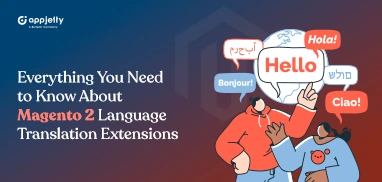Michael Aldrich is the pioneer of present-day e-commerce which he invented in 1979. He designed and manufactured a number of online shopping systems that employed Videotex technology during the ’80s. The year 1989 came and the world became witness to another path-breaking invention – World Wide Web.
In 1991, the first WWW server opened for commercial use. The first secure retail transaction on the web was by Netmarket in 1991. The year 1995 saw the launch of Amazon and eBay – two of the biggest global e-retail giants so far. These global e-retail brands made a multi-language website indispensable for e-commerce business owners.
In the e-commerce industry, your e-commerce site is the first point of contact for most of your audience. Therefore, it is important to make sure that the first point of contact doesn’t fail to drive customers’ engagement. Besides several factors like user-friendly design, high loading speed, etc.; personalization also plays a crucial role in engaging customers. And the language on your site contributes a lot to your site personalization.
A multi-language website is one of the most important requirements that you can’t do without – especially when going global.
In this post, we’ll walk you through the benefits of a multi-language website. We’ll also guide you on how to turn your business site into a multi-language website.
Benefits of a Multi-Language Website
A multilingual website has a number of benefits for your e-commerce business.
Helps Target a Larger Audience, Go Global
A multi-language website helps you expand your business and target a larger audience. As per Statista’s stat published in June last year, the total percentage of worldwide internet users speaking English is only 25.9% as of Jan. 2020. It means that if you don’t switch to a multi-language website, you’ll miss out on engaging around 75% non-native English speaking internet users.
With a multilingual website, you can open up your business to international customers and boost your customer base and sales. In fact, you can even tap into your own country’s non-native English speaking internet users better with multiple language options.
For example, English is the most widely spoken language in the US with 254 mn native English speakers. However, Spanish is the second most widely spoken language after English with around 43 mn native Spanish speakers. Chinese follows next with around 2.9 native Chinese speakers.
So, it is evident that a multi-language website not only helps enhance international customers’ but also domestic non-native English speaking customers’ experience.
Helps Reduce Bounce Rates and Boost Conversion Rates
According to CSA’s latest research on 8079 consumers across 29 countries, 76% of online shoppers prefer purchasing products with information in their native language. Also, 40% won’t buy anything from a website not in their own language.
The stats clearly highlight the importance of a multi-language website for your e-commerce business. If you have a multilingual website, your foreign customers are more likely to stay on your website for longer and browse your products.
It will help increase your site’s bounce rate. Also, providing a localized experience will help drive them to make purchases and increase conversions.
Helps Give a Competitive Edge
Covid-19 has changed the e-commerce landscape a lot with customers demanding more convenience while shopping. Having a multi-language website will add to the convenience of the international customers and boost cross-border e-commerce revenue.
It will also help you get a competitive edge over those competitors who haven’t switched to a multi-language website yet. This way, you can survive and fare well in tough times by offering multiple language options.
Helps Increase Brand Visibility Globally (By Boosting International SEO)
A multi-language website not only helps engage international customers but also enhances your brand visibility. By translating your site’s content and optimizing it for different languages, you can rank your site higher in SERPs in foreign countries too. There are some multilingual SEO practices you can follow to rank in top SERPs in your target international market.
With more countries’ audiences finding your site in top SERPs while searching for something in their native language, your site visibility will increase. As a result, more customers from the international market will know your brand and buy from you. They will also spread the word-of-mouth for your brand if they like your products/services.
Helps Build Trust and Faith
The personalization of a business is no longer a luxury but rather a necessity. If you use a customer-centric approach and provide your customers with language personalization, you can stay ahead ahead of the competition.
Browsing your site in their native language will develop a sense of trust and faith in them. They will also feel valued and acknowledged. It will help increase your brand loyalty and attract more customers with a multilingual website.
Cost-Effective Marketing
A website is the crucial part of your business – and your marketing strategy as well. So, if you optimize your website for different language-speaking customers, you can benefit from it. The highly engaging content on your site in the language of your target audience will help increase your outreach. That too at a nominal price unlike several other marketing strategies.
In fact, content marketing is 60% cheaper than other marketing techniques on an average.
So, a multilingual site can help you market your business effectively and nominally.
How to Turn Your Site into a Multi-Language Website?
There are often some challenges when it comes to making a website multilingual. However, with the right approach and right tips, you can translate your website seamlessly.
There are a few points you should consider when translating a website.
The first is the language intricacies you need to consider. The second is your site SEO that again depends on language intricacies. The third is your branding that should remain consistent across all languages. You can tweak your content but shouldn’t lose your brand personality for the sake of translation. Besides, you should ensure that translation doesn’t impact or distort your site appearance.
Related: 5 Points to Consider before Translating a Website
If you are also a store owner looking to translate your website, AppJetty can help you out.
If you have a Magento store, our Magento 2 Language Translator extension can be the right fit for you. Our Magento-certified developers have equipped it with all the next-gen features you seek in a translator extension. It has multi-language store translation, instant translations, database search and translate, WYSIWYG editor, and several more features to enhance your Google API translation capabilities. You can also translate content beyond web pages like Product, Category, and Review Pages as well.
If you have a Shopify store, our AppJetty Language Translator can be the right fit for you. Our development team has ensured to equip it with all the advanced features you seek in a Shopify translator plugin. It supports native translation, mass translation, manual and automated translation, etc. Its compatibility with all the major SEO apps and support for translation of emails and SMS, etc. ensures to make your translation smart and error-free.
Want to learn in detail how these features can help your store translation?
To know more about our products or integrate them into your store, get in touch with us. Time to go multi-lingual!
All product and company names are trademarks™, registered® or copyright© trademarks of their respective holders. Use of them does not imply any affiliation with or endorsement by them.





